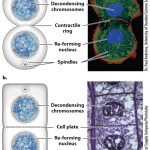Cytokinesis is the stage in the eukaryotic cell cycle where a replicating cell divides its components into 2 separate membranes, forming daughter cells. It is widely thought that cytokinesis in eukaryotes evolved from the similar process of binary fission in Prokaryotes, yet it is a more complex process in comparison due to the nature of eukaryotic DNA replication. Cytokinesis is also more complex because eukaryotes have nuclei that must break down in the beginning of the cell cycle and reform at its end. It occurs in Both meiosis and mitosis wherein in the final stage of mitosis creates 2 diploid daughter cells with the same genetic makeup as the parent cell, and in meiosis (the reproduction of germ-line cells) it occurs twice. the first division occurs after telophase of Meiosis I, and again in Meiosis II, resulting in 4 unique haploid cells. The cells are haploid in meiosis because each daughter cell contains only one pair of chromosomes that will later recombine with another germ-cell of the opposite sex.
The Picture shown above retrieved from the Biology Launchpad website shows cytokinesis in both plants and animals. All eukaryotes perform cytokinesis to divide genetic material and cytoplasmic components amongst the daughter cells, but the mechanism used to perform the separation varies between plants, animals, and fungi. In mammals, a contractile ring made of actin filaments forms at the center of the cell, and motor proteins cause the filaments to contract and will eventually pinch the cell in two, resulting in 2 new daughter cells. Plants are different because they have cell walls and do not physically separate from each other. Once the plant cell doubles in size it will create a wall of microtubules in the center called a pragmoplast that will pull in vesicles containing cell wall components towards it during telophase. The vesicles will then fuse at the center (or cell plate) to form a cell wall that is attached to the original. Fungal cytokinesis is more like animal cytokinesis and uses a contractile ring made of actomyosin.
References
Biology: How life works (2nd ed.). (2017). In B. A. Berry Andrew, Biology: How life works (2nd ed.) (p. CH 11). McGraw-Hill, NY: W. H. Freeman. Retrieved from http://www.macmillanhighered.com/launchpad/morris2e/4909413#/ebook/item/MODULE_bsi__F4951CED__2971__4486__BC4F__E109B2EE87D4/bsi__2ED633B9__F1E8__4C6C__82AA__0633C0C9F474?mode=Preview&toc=syllabusfilter&readOnly=False&renderIn=fne
“The Mitotic Phase and the G0 Phase.” Boundless Biology Boundless, 24 Mar. 2017. Retrieved 24 Apr. 2017 from https://www.boundless.com/biology/textbooks/boundless-biology-textbook/cell-reproduction-10/the-cell-cycle-88/the-mitotic-phase-and-the-g0-phase-396-11622/

